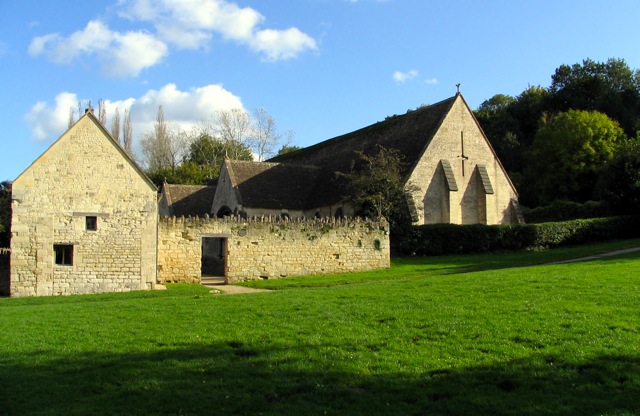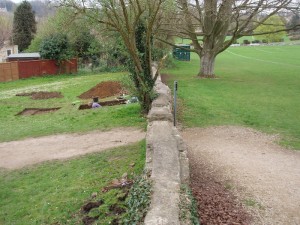.
Barton Farm, Bradford on Avon
Bradford on Avon, Wiltshire
.
Barton Farm, on the southern side of the town, beside the river Avon, was the grange farm of the Abbey of Shaftesbury’s estate of Bradford.
It was developed during the Middle Ages around a central square, with a huge barn, granary, smaller barns and a farmhouse. Together they form one of the most complete medieval farm complexes in the country.
It remained a working farm into the 1960s, so there have been many additions and alterations throughout the six centuries of its life.
George Ashmead’s map of 1837 (north is to the right) shows the buildings of Barton Farm and some of its fields, with useful reference numbers. Grouped around the yard 86 are the Tithe Barn (left), Granary (bottom), Farmhouse (right) and West Barn (top). The Pound (78) was a small enclosure for holding stray animals and gave the name to Pound Lane and Pound Close (now called Victory Field). Culver Close (88) still has that name, which derives from a former pigeonhouse (Old English culfre=pigeon or dove). Rick Field (85) was used for building haystacks, but has recently been partly planted out as an orchard (now called The Hens Orchard), whereas the real orchard was number 87, now mostly a play area and the Bowls Club’s green.
The eastern boundary of the complex (between fields 77 and 85) is enclosed by what seems to be a medieval wall. This crowns a low bank which has been excavated by members of Bradford on Avon Museum’s Research Group. Below ground are the foundations of a double wall which has been suggested to have been the defences of a royal Saxon settlement on the site, before the Abbey’s farm.
.
.
After the Abbey was dissolved in 1543 Barton Farm descended with the Manor of Bradford and was generally let to a tenant farmer. The Tithe Barn was sold by the Lord of the Manor, Sir Charles Hobhouse, to the Wiltshire Archaeology & Natural History Society in 1915. It was handed over to the Ministry of Public Buildings & Works in 1939 after restoration and is now in the care of English Heritage. The other agricultural buildings around the yard now belong to Bradford on Avon Preservation Trust, except for the farmhouse, which is in private hands. Land next to the river was bought by Wiltshire County Council in 1971 to become the Country Park. Victory Field, named at the end of World War 1, next to Pound Lane, was already in public use as a sports field and now belongs to Bradford on Avon Town Council.
For more see Bradford on Avon Museum booklet The Buildings of Barton Farm by Pam & Ivor Slocombe
For a history of the farm see Barton Farm, the last thousand years by Margaret Dobson & Gareth Slater










